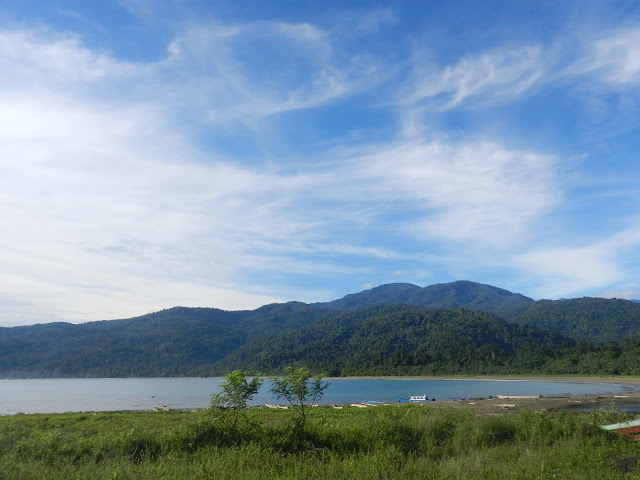IPs and Conservation
In March 2016, Strong voices came up in Out meeting from Mr. Ignasius Baru, the leader of Miyah tribe in the meeting of Two district regulation draft about customary right recognition and conservation district development. He said "community not understanding what conservation is. If what the government meant with conservation is just to say no for community to access on their resources in their customary territories, then I would say we the IPs of Tambrauw especially in Miyah tribe refuse the design of Tambrauw as conservation district". Adding to that, Victor Sundoy who is actually works in conservation management body but originally part of Abun tribes community emphasized that "Conservation need to be clearly packages because in facts we have to criminalize community once they want to touch the forests resources such as timber because conservation has say no to open the forests or extracting the resource from it. The fact the Tambrauw is 80% protected and conservation forests are not realistic if we looks from the perspective of how strong is customary community relation with the land and their high dependency on it". Despite of this complain and objection to the conservation most of the community leader who joined the discussion shown their agreement on protecting the potential resources, secret places and preserving exotic animal and ecosystem that they sees as the strength in Tambrauw that cannot found in other places.
So what are the gaps here? If the community are acknowledged the important of protecting some exotic species, landscape and ecosystem and the secret places in their are why they refused conservation that actually having the same meaning? Back to the definition, value and benefit of conservation forests may could leads us to answer the question and curiosity of the community in Tambrauw objection to conservation. As I understand from law no 5 of 1994 about Biodiversity Conservation, conservation is about wises and balance uses of forests to increase people livelihoods and sustainability ecologic function of the forests. It mentioned conservation should is implementing in (1) protecting the exotics landscape, species, ecosystem and function, (2) enriching biodiversity and (3) sustainable uses. Michael Lackwook, the Editor in Big Big of Managing Protected areas (2006) re-emphasized this that conservation or protected areas management are about clearly translating the values and benefits of them to the ecosystem and community. He notes that setting clear objection of management protected areas could reduces competition and claim of benefits to it. Most of the conservationist and socialist are debating about the people presence and existence inside conservation areas which actually the cores issues Tambrauw is facing. Half ways of implementing conservation and lack of management scenarios to maintain values and benefits of conservation seems likes the roots of the problems and has creates miss understanding and miss perception about conservation in the community. Conservation actions and applying freeze regulations with only species and ecosystem oriented while in some part under-counting the balance of social development in related to conservation development that happening in long times has raised the critical objection by the community based on their half conservation understanding.
Exploring more: Budi Riyanto (2005) on his book "
Pemberdayaa Masyarakat Sekitar Hutan dalam Perlindungan Kawasan Pelestarian Alam" has scientifically describing the connection of commmunity with nature and forests, he noted that meeting conservation objective is also about facilitating community to take parts in conservation based of the applied law. The new ICCA Groups actuallly has helped us to understand of how strong is Indigenous community with conservation and how their conservation approaches has living for generation and has successfully protects the forests. Recent 2015 study conducted by CIFOR that published in Ecology and Social Journal "
http://www.cifor.org/publications/pdf_files/articles/ABoissiere1501.pdf" re-affirming long argumentation that 'no conservation without recognition the right and roles of IPs' and I think this is how conservationist in Tambrauw should learn through. Manuel Boissiere,et all in this CIFOR publication noted that "N
atural resource management by local communities can be more effective and cost-efficient for large-scale conservation than government-sanctioned protected areas". The research with title: Unseen sentinel: Local Monitoring and Controlling in Conservation Blind Spots describing how community in up-stream of Mamberamo river has applying best but un-recognized approaches in control and monitor the uses for forests resources. Same as community in Tambrauw the community here in Mamberamo as described by CIFOR also acknowledging conservation and forest zoning that living for centuries.
Conservation District Regulation
Addressing the conservation, social and development issues that government is willing to see is about how balance can be realized, a regulation of conservation is designed. At the same time the government also draft the regulation about customary right recognition. The main of objective of this two regulation are to secure the right of IPs, with their access to managing conservation areas but also providing a legal frame of how official development plan can be implemented within clear arrangement of benefit to the land owners. Facts that de facto claim of right and forests resources and acknoledging sometime the development not applied according the community land uses zoning and management vision has pushing government and parliament to addressing the conservation policy that related to securing right and participation of IPs in the development.
Sepus Fatem, the Natural Resources Management adviser of Tambrauw District on his presentation keeps emphasized that the design of conservation in Tambrauw is not about conserve the way how forests function has been regulated by the ministry of forestry. But this about integrating national forests conservation targets with the community and government access to development. The core of conservation policy in tambrauw is to recognition traditional zoning living in community to be counted as conservation areas or else the regulation is trying to open the banned of access of community to the limited uses based on their needs and then control and monitor the amount to arrange enrichment and big protection targets on species and ecosystem that Tambrauw has. In this cases community with their right and traditional land/forests zoning are the main beneficiaries that government is paying attention on.
Community Land Right and Traditional Values to Biodiversity Conservation in Tambrauw
Community argumentation to refusing conservation should be respected since their are stepping from lack of understanding to conservation terminology that basically not coming from their own language and was accumulative of trauma in experiencing how conservation been implementing by conservation NGO/CSO and government units. "No conservation without right recognition and participation of IPs in Tambrauw" should become a basis on the design of regulation, approaches and management plan to managing conservation, official development and social empowering in Tambrauw district.
In 2015, the indicative mapping research conducted by Tambrauw Development partners consortium (WWF, Samdhana, Paradisea and AKA WUON) has recorded basic information and data about customary rights, land uses zoning and conservation approaches living with IPs in Tambrauw. The reports that presenting indicative tribe maps of Miyah and Abun tribes also describing local names and structure of decission making process of areas/forests and natural resources management within Tambrauw IPs. A year before that in 2014, WWF in collaboration with local facilitator from Abun tribe has also mapped and recorded the important places community in Abun is acknowledge. Their distributions that spreads from sea and beaches to the mountain with local names. For example, community in both Abun and Miyah has dividing forests based on the function, the reports noted:
wiam ase (local words for virgin forests),
Sre (similar to peatland but are widely spread up to the hill),
Ruf (low land forests),
Ora (active farming/crop land) and
Etiam (degraded areas after farming). Beside forest the community also action zoning for hunting, the words
Ramen, Rmoy and
Fim are describing areas for hunting and places for animals to drink.
Regulation the government is providing together with capacity building and on-sites facilitation for the community to integrating their conservation and land uses management approaches with government land uses and forests management design seems like a basic task to do to meet what they are expecting on conservation development based on customary community land right and participation.


 Press release in Matoa Cafe, Manokwari. Photo: Cahaya Papua
Press release in Matoa Cafe, Manokwari. Photo: Cahaya Papua Share an experienced in the camp. Photo by: Cahaya Papua
Share an experienced in the camp. Photo by: Cahaya Papua Panel discussion, Mr Max, Dona and Sepus with Marthen Nauw as Moderator
Panel discussion, Mr Max, Dona and Sepus with Marthen Nauw as Moderator Management Block Maps of KPHP Unit IV Tambrauw
Management Block Maps of KPHP Unit IV Tambrauw


 Main plenary led by 3 young Facilitator from AKA WUON and Marwasnath. Photo: Yunus Yumte
Main plenary led by 3 young Facilitator from AKA WUON and Marwasnath. Photo: Yunus Yumte Preparation to cultural opening Ceremony. Photo: Yunus Yumte
Preparation to cultural opening Ceremony. Photo: Yunus Yumte Group discussion as side event of main plenary - talking about territories. Photo: Yunus Yumte
Group discussion as side event of main plenary - talking about territories. Photo: Yunus Yumte Situation in the main plenary hall. Photo: Yunus Yumte
Situation in the main plenary hall. Photo: Yunus Yumte Tambrauw Beach and Mountation Forests. Photo: Yunus
Tambrauw Beach and Mountation Forests. Photo: Yunus


 Natural Sago Plots in Kais South Sorong, West Papua
Natural Sago Plots in Kais South Sorong, West Papua  Sago for local Foods, Traditional extraction by IPs in Kais, South Sorong - West Papua
Sago for local Foods, Traditional extraction by IPs in Kais, South Sorong - West Papua






